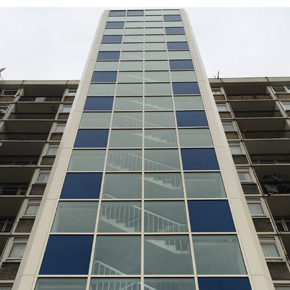
Tall building fire risk analysis by Wrightstyle
Wrightstyle‘s managing director Tim Kempster has been analysing fire safety in tall buildings, almost five months on from the Grenfell Tower tragedy.
He speaks about how the disaster will cast a long shadow in years to come and how it will define official attitudes to social housing and the imperative of fire safety in tall buildings.
In his opinion, UK authorities have been complacent in believing current regulations in place were fit for purpose, stating that it will be another instance of ‘coding by catastrophe’.
Mr Kempster says whilst official enquiries continue to grind forward, the building industry is still rattling on at pace and, with this, fire safety in tall buildings is under a scrutiny never seen before.
There are tall buildings situated all over the United Kingdom, with a large proportion of these being in London.
In the capital, 450 tall buildings are in the pipeline, with 90 of these currently being constructed.
The pace of upward development there is accelerating, with 28 tall building completions this year and 40 more set for 2018.
Any fears about Brexit appear to be dumbfounded, as this has yet to have had much of a dampening effect, according to Wrightstyle’s MD.
The above figures come courtesy of the London Tall Buildings Survey, which charts the number of 20 storey-plus towers completed, proposed or currently in planning across the capital’s 33 boroughs.
He goes onto say, with London’s high land prices, the logic of building upwards is inescapable. Therefore, creating high-rise residential blocks will help to alleviate the city’s housing shortage, providing design lessons from the past can be learned.
Adding to this, the biggest lesson for building designers, architects and fire safety experts must be to never again lapse into false security and take heed of the events of Grenfell Tower, as the real lesson from the disaster is that complacency is the enemy of fire safety.
Wrightstyle have worked on fire safety on a number of high-rise developments in the UK and internationally, publicly raising concerns about fire regulations in both the UK and United Arab Emirates.
The most effective way of dealing with fire at high altitude, he says, is by fire compartmentation, which involves keeping the fire contained in one protected area and preventing it from spreading. A contained fire can be dealt with, however an uncontrolled one cannot be.
In conclusion, he talks of how we’ve seen the good, bad and the ugly of fire safety design.
He also hopes that, with this unprecedented era of tall buildings being constructed, it is important to pay heed to the absolute need for a whole new level of fire safety.
Because, if the worst does happen, there are fire containment strategies to ensure everyone’s safety, especially in the wake of Grenfell.
Wrightstyle,
Unit 2&7 Banda Trading Estate,
Nursteed Road,
Devizes,
United Kingdom,
SN10 3DY
Visit Supplier's page
Latest news

19th April 2024
ASSA ABLOY: Access solutions can impact sustainability performance across the full life-cycle of a building
Embedding sustainability within any organisation requires a broad, strategic perspective. Scrutiny should include the physical infrastructure itself: According to the IEA, buildings consume around 30% of global energy*. ASSA ABLOY has more…
Posted in Access Control & Door Entry Systems, Architectural Ironmongery, Articles, Building Industry News, Building Products & Structures, Building Regulations & Accreditations, Building Services, Case Studies, Doors, Facility Management & Building Services, Information Technology, Research & Materials Testing, Retrofit & Renovation, Security and Fire Protection, Sustainability & Energy Efficiency, Video of the Week
19th April 2024
British weather doesn't dampen spirit for new HMG Garden Paint
Despite one of the wettest starts to the year on record, customers are starting to plan for brighter days with HydroPro Garden Paint from HMG Paints.
Posted in Articles, Building Industry News, Building Products & Structures, Garden, Innovations & New Products, Paints, Paints, Coatings & Finishes, Restoration & Refurbishment, Retrofit & Renovation, Site Preparation, Sustainability & Energy Efficiency, Waste Management & Recycling
18th April 2024
Abloy UK showcases new digital portfolio at The Security Event 2024
Abloy UK is set to unveil its latest line-up of access control systems at The Security Event 2024, welcoming guests to explore its cutting-edge electromechanical and digital solutions on stand 5/F50.
Posted in Access Control & Door Entry Systems, Architectural Ironmongery, Articles, Building Industry Events, Building Industry News, Building Products & Structures, Building Services, Doors, Exhibitions and Conferences, Facility Management & Building Services, Health & Safety, Information Technology, Retrofit & Renovation, Security and Fire Protection
18th April 2024
Strand is a Failsafe Choice for Emergency Exit and Panic Hardware
In times of emergency, you’re in safe hands with Strand Hardware. Although there are many considerations for building specification, few decisions can be as critical as selecting the right emergency exit/panic hardware.
Posted in Access Control & Door Entry Systems, Architectural Ironmongery, Articles, Building Industry News, Building Products & Structures, Building Services, Doors, Facility Management & Building Services, Health & Safety, Restoration & Refurbishment, Retrofit & Renovation, Security and Fire Protection
 Sign up:
Sign up: 